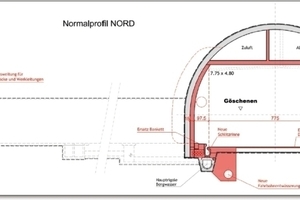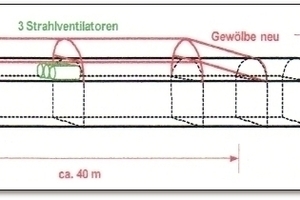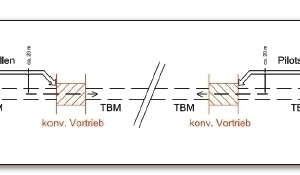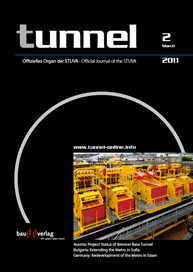Scenarios for the future of the Gotthard Road Tunnel
The Gotthard Road Tunnel (GRT), just under 17 km in length and part of the Swiss freeway system, opened to traffic in 1980, and used by more than 160 million vehicles in the intervening period, is now in need of radical renewal.
A time horizon extending from 2020 to 2025 is planned for this work, which will include, on the one hand, refurbishing and structural renewal and, on the other hand, provisions to assure conformity with modern rules and standards, and thus improved safety. The central element of this revamping of the Gotthard Road Tunnel takes the form of a new false roof. The tunnel ventilation and drainage systems also require renewal, however, as does the road surface. In addition, the tunnel cross-section available to traffic must be expanded, the distances between the emergency lay-bys reduced, the road shoulders widened, and the cross-section of the escape tunnel enlarged.
Traffic management during refurbishing
Traffic management during this project is of central importance, in view of the national and international significance of the GRT; alternative routes are to be provided for passenger and goods traffic. An official proposal by Switzerland‘s Federal Roads Office (German abbreviation: Astra) focuses, on the basis of current planning for car traffic, on the setting-up of a car-shuttle service through the original Gotthard rail tunnel (from Göschenen to Airolo). A „rolling highway“ via the Gotthard Base Tunnel (from Erstfeld to Bodio) is conceivable for freight traffic, according to further statements by Astra.
Refurbishing possible without a second tunnel
Even deploying these alternatives, combined with other supporting provisions, it will not be possible to completely eliminate disruptions resulting from prolonged closure of the GRT. The Swiss Federal Council has also ascertained in its report „Global Gotthard Road Tunnel Concept“ that refurbishing of the existing tunnel will be possible without the construction of a second bore. As also stated by Astra, a second bore, the costs of which are estimated at more than 2 billion CHF, would necessitate simultaneous expansion of capacity on the Gotthard route as a whole, would have constitutional consequences, and could, anyway, scarcely be completed before the start of the refurbishing work on the existing bore. Alternative scenarios have also been sought, since this solution would entail negative effects on the host cantons of Ticino and Uri, in particular. The transport and motoring organisations, in particular, are demanding the creation of a second bore, whereas the Canton of Uri favours the construction of a variant referred to as a „replacement tunnel“. Since the closure of the Gotthard route for a period of two-and-a-half to three-and-a-half years (with interruptions), depending on the project variant selected, would not be economically sustainable for Uri, this mountainous canton favours as an element in the concept the construction of a new tunnel without refurbishing of the existing bore. Such a replacement tunnel would permit reassessment of the situation at a later time, relieving the pressure on the political decision-making process.
Criteria for structural renewal
The scope of refurbishing work necessary for the GRT derives from the present condition of the structure and the predicted future performance of its fabric. Astra‘s „Global Gotthard Road Tunnel Concept“ project report analyses, on the one hand, the present tunnel‘s serviceability and conformity with the relevant standards, and discusses the necessary civil-engineering work:
• The structural condition of the false roof can be described even now as defective in some cases, and is worse in the two portal zones, in particular, than in the other sectors of the tunnel. Well-advanced corrosion of the lower reinforcement areas has been ascertained in these zones, and there are no further load-bearing safety margins here. This signifies the necessity for the replacement of the existing false tunnel roof, including the inner vaulting.
• The carriageway surface in the GRT has not been replaced since commissioning of the tunnel in 1980; its effective service-life was originally estimated at twenty years, a period which thus expired in 2000. The surface is, however, in principle in good condition, but requires replacement in the context of the refurbishing work.
• The condition of the rock lining in the escape tunnel running parallel to the main bore will deteriorate in the next few years. This facility‘s stability is not endangered, however, and major reinforcement work will, according to the Astra report, not be necessary for the next twenty years. The equipment in the escape tunnel is in good condition, although the space available for utility lines needs enlargement.
• Special work is necessary to restore the conformity of the GRT with the relevant rules and standards; at its present 4.50 m, the height of the effective tunnel cross-section available to traffic no longer fulfils these requirements. The overall height of the unobstructed clearance profile of 5.20 m specified by the applicable standard can be achieved in the GRT only by simultaneous raising of the false roof and lowering of the carriageway.
• Sector-by-sector modernisation of the ventilation system: due to its length, the GRT is subdivided into five ventilation sectors, which are defined by the four existing underground ventilation centres and the appurtenant ventilation shafts extending up to the surface. The assurance of high availability of the upcast ventilation systems at all times necessitates significant modifications to the load-bearing structure of the tunnel vaulting. It will be necessary, on the one hand, to create additional caverns at the ventilation centres and, on the other hand, to raise the tunnel roof above the carriageway at twelve points (excavation of the roof in order to enlarge tunnel height).
Second Gotthard bore a political decision
The construction of a second tunnel bore prior to the refurbishing of the existing GRT, which would bring about a radically improved traffic situation, is under intense discussion at political level. The time required for construction of a second tunnel bore is estimated in the Astra report at around seven years from award of contract, assuming the use of two tunnel-boring machines tunnelling toward each other simultaneously, from Göschenen and from Airolo, respectively. The known problematical geological zones would need to be prepared in advance, in order that they can be traversed with the smallest possible loss of time. This implies additional pilot tunnels, from which the tunnel profile can firstly be conventionally excavated in the critical zones.




